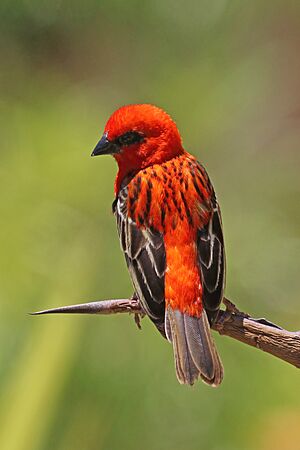Red fody facts for kids
Quick facts for kids Red fody |
|
|---|---|
 |
|
| Tsimanampetsotsa National Park, Madagascar | |
 |
|
| Toliara, Madagascar | |
| Conservation status | |
| Scientific classification | |
| Genus: |
Foudia
|
| Species: |
madagascariensis
|
| Synonyms | |
|
Loxia madagascariensis Linnaeus, 1766 |
|
The red fody (Foudia madagascariensis) is a small, colorful bird. People also call it the Madagascar fody or red cardinal fody. It comes from Madagascar but now lives on many other islands in the Indian Ocean. This bird is quite common, so experts say it is not in danger of disappearing.
Contents
About the Red Fody's Name
The red fody got its scientific name, Loxia madagascariensis, from a famous scientist named Carl Linnaeus in 1766. He was the one who created the system we use today to name all living things. Later, in 1850, another scientist named Ludwig Reichenbach placed this bird into a special group called the Foudia genus. The red fody is the main example for this group of birds.
What the Red Fody Looks Like
The red fody is about 5 inches (13 cm) long. It weighs about 14–19 grams (0.49–0.67 oz), which is like a few pieces of candy.
Male Red Fody
Male red fodies are very easy to spot because they are bright red! They have black marks around their eyes, like a mask. Their wings and tail are brown. Their red belly helps tell them apart from other fody birds in places where they have been introduced.
Female Red Fody
Female red fodies are not as colorful. Their top feathers are olive-brown, and their belly is a greyish-brown color.
Where Red Fodies Live
Red fodies are originally from Madagascar. They like open areas like forest clearings, grassy fields, and farms. You won't usually find them in thick forests.
This bird has also been brought to other islands in the Indian Ocean, such as the Comoros, Seychelles, Mauritius, and Réunion. In Madagascar, farmers sometimes see them as a problem because they eat rice crops.
What Red Fodies Eat
Red fodies mostly eat seeds, especially grass seeds. They also enjoy eating insects. Sometimes, they will eat fruit, nectar from flowers, and even food scraps left by people.
Red Fody Life and Habits
Outside of the time when they are raising their young, red fodies like to live in groups.
Nesting and Reproduction
When it's time to have babies, the male fody finds a territory about 30 m (100 ft) wide. Red fodies usually have one partner. The male starts building a nest in the middle of his territory before he even finds a mate. Many nests can be found close together in small groups.
The nest is shaped like a ball with an opening on the side, sometimes with a small tunnel. The male bird does most of the building. He uses roots, vines, grass, and other long plant pieces to weave the nest together. It takes about eight days to build a nest. If a male can't find a mate, he might leave the nest unfinished.
Impact on Other Birds
When red fodies are introduced to new islands, they can sometimes affect the birds that already live there. For example, on Mauritius, the endangered Mauritius fody has faced challenges because the red fody competes for the same food and places to live. The same has happened with the Rodrigues fody on Rodrigues Island.
Gallery
See also
 In Spanish: Fodi rojo para niños
In Spanish: Fodi rojo para niños








